Second plague pandemic
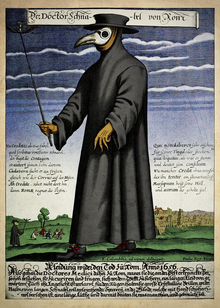
Thesecond plague pandemicwas a major series of epidemics ofplaguethat started with theBlack Death,which reachedmedieval Europein 1346 and killed up to half of the population ofEurasiain the next four years. It followed thefirst plague pandemicthat began in the 6th century with thePlague of Justinian,but had ended in the 8th century. Although the plague died out in most places after 1353, it becameendemicand recurred regularly. A series of major epidemics occurred in the late 17th century, and the disease recurred in some places until the late 18th century or the early 19th century.[1][2]After this, a new strain of the bacterium gave rise to thethird plague pandemic,which started in Asia around the mid-19th century.[3][4]
Plague is caused by the bacteriumYersinia pestis,which exists in parasitic fleas of several species in the wild and of rats in human society. In an outbreak, it may kill all of its immediate hosts and thus die out, but it can remain active in other hosts that it does not kill, thereby causing a new outbreak years or decades later.
Overview
[edit]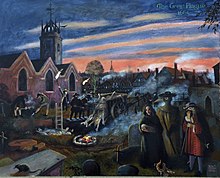
There have been three major outbreaks of plague. ThePlague of Justinianin the 6th and 7th centuries is the first known attack on record, and marks the first firmly recorded pattern ofplague.From historical descriptions, as much as 40% of the population ofConstantinopledied from the plague. Modern estimates suggest that half of Europe's population died as a result of thisfirst plague pandemicbefore it disappeared in the 700s.[5]After 750, plague did not appear again in Europe until the Black Death of the 14th century.[6]
The second pandemic's origins are disputed; it originated either inCentral Asiaor Crimea,[7][8][9][10][11][12][13]and appeared inCrimeaby 1347. It may have reduced the world population from an estimated 450 million to 350–375 million by the year 1400.[14]Evidence forYersinia pestiswas found in the teeth of early plague victims in theTian Shan mountains,now northernKyrgyzstan,indicating a likely origin of that iteration of the plague.[15]
The plague returned at intervals with varyingvirulenceand mortality until the early 19th century. In England, for example, the plague returned between 1360 and 1363, killing 20% of Londoners, and then again in 1369, killing 10–15%.[16]
In the 16th century, the plague hitSan Cristóbal de La Lagunain theCanary Islandsbetween 1582 and 1583.[17]
In the 17th century, there were a series of European "great plague" outbreaks: theGreat Plague of Sevillebetween 1647 and 1652, theGreat Plague of Londonbetween 1665 and 1666,[18]and theGreat Plague of Viennain 1679.The great plague of northern Chinaarose in Shanxi in 1633 and arrived at Beijing in 1641, contributing to the downfall of the Ming Dynasty in 1644.[citation needed]
In the 18th century, there was theGreat Plague of Marseille,which took place between 1720 and 1722;[19]theGreat Plague of 1738,which occurred in Eastern Europe between 1738 and 1740; and theRussian plague of 1770–1772,which took place inCentral Russiaand particularly affected Moscow. However, the plague in its virulent form seemed to gradually disappear from Europe, though lingering in Egypt and the Middle East.[citation needed]
By the early 19th century, the threat of plague had diminished, though it was quickly replaced by the spread of another deadly infectious disease in thefirst cholera pandemic,beginning in 1817, the first of severalcholerapandemics to sweep through Asia and Europe during the 19th and 20th centuries.[20]
Thethird plague pandemichit China in the 1890s and devastated India. While it was largely contained in the East, it became endemic in the western United States, where sporadic outbreaks of plague continue to occur.[11]
Black Death
[edit]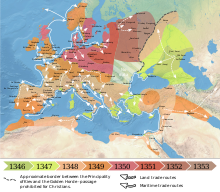
Arab historiansIbn Al-WardiandAlmaqrizibelieved the Black Death originated inMongolia,and Chinese records show a huge outbreak in Mongolia in the early 1330s.[21]
In recent years, more research has emerged that shows the Black Death most likely originated on the northwestern shores of theCaspian Sea,[22]and may not even have reached India and China, as research on theDelhi Sultanateand theYuan Dynastyshowed no evidence of any serious epidemic in 14th-century India and no specific evidence of plague in 14th-century China.[9]
There were large epidemics in China in 1331 and between 1351 and 1354 in the provinces ofHebei,Shanxi,and others, which are considered to have killed between 50% and 90% of the local populations, with numbers running into the tens of millions. However, there is no proof currently that these were caused by plague, though there are indications for the second set of epidemics.[23]Europe was initially protected by a hiatus in theSilk Road.[citation needed]
Plague was reportedly first introduced to Europe viaGenoesetraders from their port city ofKaffainCrimeain 1347. During a protractedsiege of the city,between 1345 and 1346, the MongolGolden Hordearmy ofJani Beg,whose mainlyTatartroops were suffering from the disease,catapulted infected corpsesover the city walls of Kaffa to infect the inhabitants,[24]though it is more likely that infected rats travelling across the siege lines spread the epidemic to the inhabitants.[25][26]As the disease took hold, Genoese traders fled across theBlack SeatoConstantinople,where the disease first arrived in Europe in summer 1347.[27]The epidemic there killed the 13-year-old son of theByzantine emperor,John VI Kantakouzenos,who wrote a description of the disease modelled onThucydides' account of the 5th-century BCEPlague of Athens,but noting the spread of the Black Death by ship between maritime cities.[27]Nicephorus Gregorasalso described in writing toDemetrios Kydonesthe rising death toll, the futility of medicine against it, and the panic of the citizens.[27]
It arrived atGenoaandVenicein January 1348, while simultaneously spreading throughAsia Minorand into Egypt. Thebubonicform was described graphically inFlorenceinThe DecameronandGuy de Chauliacalso described thepneumonicform atAvignon.It rapidly spread to France and Spain and, by 1349, was in England. In 1350, it was afflicting Eastern Europe and had reached the centre of Russia by 1351.[citation needed]
The 14th-century eruption of the Black Death had a drastic effect on Europe's population, irrevocably changing its social structures, and resulted in the widespread persecution of minoritiessuch as Jews,foreigners, beggars, andlepers.The uncertainty of daily survival has been seen as creating a generalmood of morbidity,influencing people to "live for the moment", as illustrated byGiovanni BoccaccioinThe Decameron(1353).[28]Petrarch,noting the unparalleled and unbelievable extremity of the disease's effects, wrote that "happy posterity, who will not experience such abysmal woe... will look upon our testimony as a fable".[29][30]
Recurrences
[edit]The second pandemic spread throughout Eurasia and theMediterranean Basin.The plague repeatedly returned to haunt Europe and the Mediterranean Basin throughout the 16th to 17th centuries.[31]The plague ravaged much of theIslamic world.[32]Plague was present in at least one location in the Islamic world virtually every year between 1500 and 1850.[33]According to Jean-Noel Biraben, plague was present somewhere in Europe in every year between 1346 and 1671.[34]According to Ellen Schiferl, between 1400 and 1600, there was a plague epidemic recorded in at least one part of Europe for every year except 1445.[35][30]
Byzantine Empire and Ottoman Empire
[edit]In theByzantine Empire,the 1347 Black Death outbreak in Constantinople lasted a year, but plague recurred ten times before 1400.[27]Plague was repeatedly reintroduced to the city because of its strategic location between theMediterranean Seaand theBlack Sea,and between Europe and Asia, as well as its position as the imperial capital.[27]
Constantinople retained its imperial status at the centre of theOttoman Empireafter theFall of ConstantinopletoMehmed the Conquerorin 1453.[27]Approximately 1–2% of the city's population died annually of plague.[27]Especially severe episodes were recorded by the Ottoman historiansMustafa ÂlîandHora Saadettinbetween 1491 and 1503, with 1491 through 1493 being the most afflicted years.[27]Plague returned in 1511 until 1514 and, after 1520, wasendemicin the city until 1529.[27]Plague was endemic in Constantinople again between 1533 and 1549, 1552 and 1567, and for most of the remaining 16th-century.[27]
In the 17th century, plague epidemics within Constantinople were noted in the following years: 1603, 1611 to 1613, 1647 to 1649, 1653 to 1656, 1659 to 1688, 1671 to 1680, 1685 to 1695, and 1697 to 1701.[citation needed]
In the 18th century, there were 64 years in which plague broke out in the capital, and a further 30 plague years which occurred in the first half of the 19th century.[27]Of these later 94 plague epidemics in Constantinople between 1700 and 1850, six of them—occurring in 1705, 1726, 1751, 1778, 1812, and 1836—are estimated to have killed more than 5% of the population, whereas 83 of the epidemics killed 1% or fewer.[27][clarification needed]
Plague repeatedly struck the cities of North Africa. Between 1620 and 1621,Algierslost 30,000–50,000 people to it, with outbreaks returning in 1654 to 1657, 1665, 1691, and 1740 to 1742.[36]
Plague remained a major event in Ottoman society until the second quarter of the 19th century. Between 1701 and 1750, 37 large-scale and smaller epidemics were recorded in Constantinople, with a further 31 occurring between 1751 and 1800.[37]TheGreat Plague of 1738affected Ottoman territory in theBalkans,lasting until 1740.[citation needed]
Baghdadsuffered severely from visitations of the plague, with outbreaks reducing the population to one-third of its size by 1781.[38]
One of the last epidemics to strike the Balkans during the second plague pandemic wasCaragea's plague,between 1813 and 1814.[16]
Swiss explorerJohann Ludwig Burckhardtwitnessed the plague epidemics that ravagedHejazandEgyptbetween 1812 and 1816. He wrote: "In five or six days after my arrival [inYanbu] the mortality increased; forty or fifty persons died in a day, which, in a population of five or six thousand, was a terrible mortality. "[39]
Holy Roman Empire
[edit]
Although regular outbreaks of disease were common for decades prior to 1618, theThirty Years' War(1618–48) greatly accelerated their spread. Based on local records, military action accounted for less than 3% of civilian deaths; the major causes were starvation (12%) and bubonic plague (64%).[40]The modern consensus is that the population of theHoly Roman Empiredeclined from 18–20 million in 1600 to 11–13 million in 1650, and did not regain pre-war levels until 1750.[41]
TheGreat Plague of Viennastruck Vienna, the dynastic seat of the Holy Roman Empire, in 1679,[16]killing an estimated 76,000 people.Emperor Leopold Ifled the city upon the outbreak. He vowed to erect aMarian columnin thanksgiving if the plague would end. Vienna'sPlague Column,located on theGraben,was commissioned in 1683 and inaugurated in 1694.[citation needed]
Italian Peninsula
[edit]- See alsoBlack Death in Italy
By 1357, the plague had returned to Venice, and from 1361 to 1363, the rest of Italy experienced the first recurrence of the pandemic.[30]Pisa,PistoiaandFlorenceinTuscanywere especially badly affected; therepesta secunda,'second pestilence' killed a fifth of the population.[30]In thepesta tertia,'third pestilence' of 1369 to 1371, 10–15% died.[30]
Survivors were aware that the Black Death of 1347–51 was not a unique event and that life was now "far more frightening and precarious than before".[30]The Italian peninsula was struck with an outbreak of plague in 68% of the years between 1348 and 1600.[30]There were 22 outbreaks of plague inVenicebetween 1361 and 1528.[42]Petrarch,writing toGiovanni Boccaccioin September 1363, lamented that while the Black Death's arrival in Italy in 1348 had been mourned as an unprecedented disaster, "Now we realize that it is only the beginning of our mourning, for since then this evil force, unequalled and unheard of in human annals through the centuries, has never ceased, striking everywhere on all sides, on the left and right, like a skilled warrior."[43][30]
In theJubilee Yearof 1400, announced byPope Boniface IX,one of the most severe occurrences of plague was exacerbated by the many pilgrims making their way to and from Rome; in the city itself 600–800 died daily.[30]As recorded by the undertakers' records in Florence, at least 10,406 people died; the total death toll was estimated at twice that figure by 15th-century chronicler Giovanni Morelli.[30]Half of the population of Pistoia and its hinterland were killed that year.[30]
Another outbreak occurred inPaduain 1405 and claimed 18,000 lives.[30]In the plague epidemic of 1449–52, 30,000Milanesedied in 1451 alone.[30]
A particularly deadly plague struck Italy between 1478 and 1482.[30]The territories of theRepublic of Venicesaw 300,000 dead in the epidemic's eight-year course.[30]Luca Landucciwrote in 1478 that the citizens of Florence "were in a sorry plight. They lived in dread, and no one had any heart to work. The poor creatures could not procure silk or wool... so that all classes suffered."[30]In addition to plague, Florence was suffering both fromexcommunicationleading to war with thePapal Statesand from the political strife following thePazzi conspiracy.[30]
In 1479, the plague broke out in Rome;Bartolomeo Platina,the head of theVatican Librarywas killed, andPope Sixtus IVfled the city and was absent for more than a year.[30]Federico da Montefeltro,Duke of Urbino,also died.[30]
Following theSack of Rome in 1527byCharles V, Holy Roman Emperor,plague broke out in both Rome and Florence. The plague emerged in Rome and killed 30,000 Florentines—a quarter of the city's inhabitants.[30]TheDescription of the Plague at Florence in the Year 1527,byLorenzo di Filippo Strozzi,records this plague in detail; it was copied out byNiccolò Machiavelliwith annotations by Strozzi.[30]He wrote:
Our pitiful Florence now looks like nothing but a town which has been stormed by infidels and then forsaken. One part of the inhabitants... have retired to distant country houses, one part is dead, and yet another part is dying. Thus the present is torment, the future menace, so we contend with death and only live in fear and trembling. The clean, fine streets which formerly teemed with rich and noble citizens are now stinking and dirty; crowds of beggars drag themselves through them with anxious groans and only with difficulty and dread can one pass them. Shops and inns are closed, at the factories work has ceased, the law courts are empty, the laws are trampled on. Now one hears of some theft, now of some murder. The squares, the market places on which citizens used frequently to assemble, have now been converted into graves and into the resort of the wicked rabble.... If by chance relations meet, a brother, a sister, a husband, a wife, they carefully avoid each other. What further words are needed? Fathers and mothers avoid their own children and forsake them.... A few provision stores are still open, where bread is distributed, but where in the crush plague boils are also spread. Instead of conversation... one hears now only pitiful, mournful tidings – such a one is dead, such a one is sick, such a one has fled, such a one is interned in his house, such a one is in hospital, such a one has nurses, another is without aid, such like news which by imagination alone would suffice to makeAesculapiussick.
— Lorenzo di Filippo Strozzi,Description of the Plague at Florence in the Year 1527
Further plague epidemics accompanied theSiege of Florencein 1529; there, religious buildings became hospitals and 600 temporary structures were built to house the infected outside the city walls.[30]
After 1530, political strife calmed and warfare in Italy became less frequent. Subsequently, plague outbreaks became more rare, affecting only individual cities or regions,[30]but were particularly severe.[30]In the 43 years between 1533 and 1575, there were 18 epidemics of plague.[30]The especially damaging Italian plague of 1575–78 travelled both north and southwards through the peninsula from either end; the death toll was particularly high.[30]By official reckoning, Milan lost 17,329 to plague in 1576, whileBresciarecorded 17,396 killed in a town that did not exceed 46,000 total inhabitants.[30]Venice, meanwhile, saw between a quarter and a third of its population die of plague in the epidemic of 1576–77 with 50,000 deaths.[44][30]
In the first half of the 17th century, a plague claimed some 1.7 million victims in Italy, or about 14% of the population.[45]
TheGreat Plague of Milan(1629–31) was possibly the most disastrous of the century: the city of Milan lost half its population of about 100,000, while Venice was as afflicted as in its severe 1553–56 outbreak.[30]
The Italian Plague of 1656–57 was the last major catastrophic plague in Italy, with theNaples Plaguethe most severe.[30]In 1656, the plague killed about half ofNaples's 300,000 inhabitants.[46]
Messinasaw the last epidemic in Italy, in 1742–44.[30]The final recorded incidence of plague in Italy was in 1815–16, when plague broke out in Noja, a town nearBari.[30]
Northern Europe
[edit]Over 60% of Norway's population died from 1348 to 1350.[47]The last plague outbreak ravagedOsloin 1654.[48]
In Russia, the disease hit somewhere once every five or six years from 1350 to 1490.[49]In 1654, the Russian plague killed about 700,000 inhabitants.[50][51]
In 1709–13, aplague epidemicfollowed the start of theGreat Northern War(1700–1721), betweenSwedenand theTsardom of Russiaand its allies,[52] killing about 100,000 in Sweden[53]and 300,000 inPrussia.[54]The plague killed two-thirds of the inhabitants ofHelsinki,[55]and claimed a third ofStockholm's population.[56]This was the last plague in Scandinavia, but theRussian plague of 1770–1772killed up to 100,000 people inMoscow.[57]
Eastern Europe
[edit]The 1560s European wave of the plague first hit Lithuania and Russian Pskov in 1564-1565 but didn't progress further east until 1566, when it ravaged in Muscovian lands already suffering from theLivonian Warand theOprichnina.It made a pause until hitting even harder in two waves in 1569-1570 and 1571-1572, which, combined with concurrent famine, may have killed between a third and a quarter of Russian population.[58]
TheGreat Plague of 1738was a pandemic of plague lasting 1738–40 and affecting areas in the modern nations ofRomania,Hungary,Ukraine,Serbia,Croatia,andAustria.[16]TheRussian plague epidemic of 1770-1772killed as many as 100,000 people inMoscowalone, with thousands more dying in the surrounding countryside.[59]
France
[edit]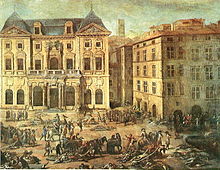
In 1466, perhaps 40,000 people died of plague in Paris.[60]During the 16th and 17th centuries, plague visited Paris nearly once every three years on average.[61]According to historianGeoffrey Parker,"Francealone lost almost a million people to plague in the epidemic of 1628–31. "[62]Western Europe's last major epidemicoccurred in 1720 in Marseilles.[47]
Britain
[edit]Plague epidemics ravaged London in the1563 London plague,in 1593, 1603, 1625, 1636, and 1665,[63]reducing its population by 10 to 30% during those years.[64]The 1665–66Great Plague of Londonwas the final major epidemic of the pandemic, with the last death of plague in thewalledCity of Londonrecorded fourteen years later in 1679.[citation needed]
Low Countries
[edit]Over 10% ofAmsterdam's population died in 1623–25, and again in 1635–36, 1655, and 1664.[65]
Iberia
[edit]More than 1.25 million deaths resulted from the extreme incidence of plague in 17th-centurySpain.[66]Theplague of 1649probably reduced the population ofSevilleby half.[54]
Malta
[edit]Malta suffered from a number of plague outbreaks during the second pandemic between the mid-14th and early 19th centuries. The most severe outbreak was theepidemic of 1675–1676,which killed around 11,300 people,[67]followed by theepidemic of 1813–1814andthat of 1592–1593,which killed around 4,500 and 3,000 people respectively.[68][69]
Tenerife
[edit]The 1582 Tenerife plague epidemic (also 1582San Cristóbal de La Lagunaplague epidemic) was an outbreak of bubonic plague that occurred between 1582 and 1583 on the island ofTenerife,Spain. It is currently believed to have caused between 5,000 and 9,000 deaths on an island with fewer than 20,000 inhabitants at that time (approximately 25-45% of the island's population).[70]
Major outbreaks
[edit]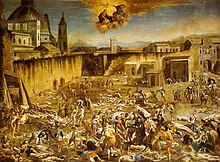
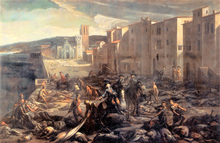
Disappearance
[edit]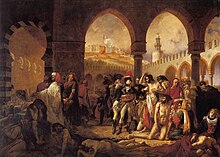
The 18th- and 19th-century outbreaks, though severe, marked the retreat of the pandemic from most of Europe (18th century), northern Africa, and the Near East (19th century).[84]The pandemic died out progressively across Europe. One documented case was in 17th-century London, where the first properdemographer,John Graunt,failed by just five years to see the last recorded death from plague, which happened in 1679, 14 years after theGreat Plague of London.The reasons it died out totally are not well understood.[85]It is tempting to think that theGreat Fire of Londonthe next year destroyed the hiding places of the rats in the roofs. There was not a single recorded plague death "within the walls" after 1666. However, by this time, the city had spread well beyond the walls, which contained most of the fire, and most plague cases happened beyond the limits of the fire. Likely more significant was the fact that all buildings after the fire were constructed of brick rather than wood and other flammable materials.[citation needed]
This pattern was broadly followed after major epidemics in northern Italy (1631), southern and eastern Spain (1652), southern Italy and Genoa (1657), and Paris (1668).
Appleby[86]considers six possible explanations:
- People developed immunity.
- Improvements in nutrition made people more resistant.
- Improvements in housing, urbansanitationand personal cleanliness reduced the number of rats and rat fleas.
- The dominant rat species changed. (The brown rat did not arrive in London until 1727.)
- Quarantine methods improved in the 17th century.
- Some rats developed immunity, so fleas never left them in droves to humans; non-resistant rats were eliminated and this broke the cycle.
Synder suggests[87]that the replacement of theBlack rat(Rattus rattus), which thrived among people and was frequently kept as a pet, by the more aggressive and prolificNorway or brown rat(Rattus norvegicus) was a major factor. The Brown rat, which arrived as an invasive species from the East, is skittish and avoids human contact, and its aggressive and asocial behaviour made it less attractive to humans. As the Brown rat violently drove out the Black rat in country after country, becoming the dominant species in that ecological niche, rat-to-human contact declined, as did the opportunities for plague to pass from rat fleas to humans. One of the major demarcations for hot spots in thethird plague pandemicwas the places where the Black rat had yet to be replaced, such asBombay(now Mumbai) in India.[citation needed]
It has also been suggested that evolutionary processes may have favoured less virulent strains of the pathogenYersinia pestis.[88]
In all probability, almost all of these factors had some effect in bringing about the end of the pandemic, though the main cause may never be conclusively determined. The disappearance happened rather later in the Nordic and eastern European countries, but there was a similar halt after major epidemics.[citation needed]
See also
[edit]References
[edit]Notes
- ^Spyrou, Maria A.; Keller, Marcel; Tukhbatova, Rezeda I.; Scheib, Christiana L.; Nelson, Elizabeth A.; Andrades Valtueña, Aida; Neumann, Gunnar U.; Walker, Don; Alterauge, Amelie; Carty, Niamh; Cessford, Craig (2019-10-02)."Phylogeography of the second plague pandemic revealed through analysis of historical Yersinia pestis genomes".Nature Communications.10(1): 4470.Bibcode:2019NatCo..10.4470S.doi:10.1038/s41467-019-12154-0.ISSN2041-1723.PMC6775055.PMID31578321.
- ^Guellil, Meriam; Kersten, Oliver; Namouchi, Amine; Luciani, Stefania; Marota, Isolina; Arcini, Caroline A.; Iregren, Elisabeth; Lindemann, Robert A.; Warfvinge, Gunnar; Bakanidze, Lela; Bitadze, Lia (2020-11-10)."A genomic and historical synthesis of plague in 18th century Eurasia".Proceedings of the National Academy of Sciences.117(45): 28328–28335.Bibcode:2020PNAS..11728328G.doi:10.1073/pnas.2009677117.ISSN0027-8424.PMC7668095.PMID33106412.
- ^"The History of Plague – Part 1. The Three Great Pandemics".jmvh.org.Archivedfrom the original on 2019-10-02.Retrieved2021-01-15.
- ^Bramanti, Barbara; Dean, Katharine R.; Walløe, Lars; Chr. Stenseth, Nils (2019-04-24)."The Third Plague Pandemic in Europe".Proceedings of the Royal Society B: Biological Sciences.286(1901).doi:10.1098/rspb.2018.2429.ISSN0962-8452.PMC6501942.PMID30991930.
- ^"Plague, Plague Information, Black Death Facts, News, Photos",National Geographic,archived fromthe originalon November 28, 2007,retrieved3 November2008
- ^Hays 2005,p. 23.
- ^Hollingsworth, Julia (24 November 2019)."Black Death in China: A history of plagues, from ancient times to now".CNN.Archivedfrom the original on 6 March 2020.Retrieved24 March2020.
- ^Benedictow 2004,p. 50-51.
- ^abSussman, George D. (2011)."Was the Black Death in India and China?".Bulletin of the History of Medicine.85(3): 319–355.doi:10.1353/bhm.2011.0054.JSTOR44452010.PMID22080795.S2CID41772477.Archivedfrom the original on 2021-06-02.Retrieved2020-12-06.
- ^Bramanti et al. 2016,pp. 1–26.
- ^abWade 2010.
- ^"Black Death | Causes, Facts, and Consequences".Encyclopædia Britannica.Archivedfrom the original on 9 July 2019.Retrieved2020-03-01.
- ^Wade, Nicholas."Black Death's Origins Traced to China".query.nytimes.Archivedfrom the original on 2020-03-01.Retrieved2020-03-01.
- ^Historical Estimates of World Population,Census.gov,archivedfrom the original on 9 July 2012,retrieved27 December2012
- ^Spyrou, Maria A.; Musralina, Lyazzat; Gnecchi Ruscone, Guido A.; Kocher, Arthur; Borbone, Pier-Giorgio; Khartanovich, Valeri I.; Buzhilova, Alexandra; Djansugurova, Leyla; Bos, Kirsten I.; Kühnert, Denise; Haak, Wolfgang (2022-06-15)."The source of the Black Death in fourteenth-century central Eurasia".Nature.606(7915): 718–724.Bibcode:2022Natur.606..718S.doi:10.1038/s41586-022-04800-3.ISSN1476-4687.PMC9217749.PMID35705810.S2CID249709693.
- ^abcdChisholm, Hugh,ed. (1911)..Encyclopædia Britannica.Vol. 21 (11th ed.). Cambridge University Press.
- ^Rodriguez, José Miguel (June 6, 2019)."12. LAS EPIDEMIAS EN LA HISTORIA: la peste en La Laguna (1582-1583)".Archivedfrom the original on July 2, 2024.RetrievedJuly 2,2024.
- ^A list of National epidemics of plague in England 1348–1665,Urbanrim.org.uk,archivedfrom the original on 8 May 2009,retrieved3 November2008
- ^Plague History Provence, – by Provence Beyond,Beyond.fr,archivedfrom the original on 9 February 2020,retrieved3 November2008
- ^"Cholera's seven pandemics".CBC News. 2 December 2008.
- ^Sean Martin (2001). "Chapter One".Black Death.Harpenden, UK: Pocket Essentials. p. 14.
- ^Benedictow 2004,pp. 50–51.
- ^McNeill 1998.
- ^Wheelis 2002.
- ^Barras & Greub 2014."In the Middle Ages, a famous although controversial example is offered by the siege of Caffa (now Feodossia in Ukraine/Crimea), a Genovese outpost on the Black Sea coast, by the Mongols. In 1346, the attacking army experienced an epidemic of bubonic plague. The Italian chronicler Gabriele de' Mussi, in hisIstoria de Morbo sive Mortalitate quae fuit Anno Domini 1348,describes quite plausibly how the plague was transmitted by the Mongols by throwing diseased cadavers with catapults into the besieged city, and how ships transporting Genovese soldiers, fleas and rats fleeing from there brought it to the Mediterranean ports. Given the highly complex epidemiology of plague, this interpretation of the Black Death (which might have killed >25 million people in the following years throughout Europe) as stemming from a specific and localized origin of the Black Death remains controversial. Similarly, it remains doubtful whether the effect of throwing infected cadavers could have been the sole cause of the outburst of an epidemic in the besieged city. "
- ^Byrne, Joseph Patrick (2012). "Caffa (Kaffa, Fyodosia), Ukraine".Encyclopedia of the Black Death.Santa Barbara, California: ABC-CLIO. p. 65.ISBN978-1-59884-253-1.
- ^abcdefghijklByrne, Joseph Patrick (2012). "Constantinople/Istanbul".Encyclopedia of the Black Death.Santa Barbara, California: ABC-CLIO. p. 87.ISBN978-1-59884-254-8.OCLC769344478.
- ^"Boccaccio: The Decameron, 'Introduction'".Fordham.edu.Archivedfrom the original on 1 October 2011.Retrieved10 December2011.
- ^Petrarch,Epistolae familiaresIV.12.208
- ^abcdefghijklmnopqrstuvwxyzaaabacadaeafWhite, Arthur (2014). "The Four Horsemen".Plague and Pleasure: The Renaissance World of Pius II.Washington D.C.: Catholic University of America Press. pp. 21–48.ISBN978-0-8132-2681-1.
- ^Porter 2009,p. 25.
- ^The Islamic World to 1600: The Mongol Invasions (The Black Death),Ucalgary.ca, archived fromthe originalon January 31, 2009,retrievedDecember 10,2011
- ^Byrne 2008,p. 519.
- ^Hays 1998,p. 58.
- ^Schiferl, Ellen (1983). "Iconography of plague saints in fifteenth-century Italian painting".Fifteenth Century Studies.6:205–225.
- ^abDavis 2003,p. 18.
- ^Université de Strasbourg. Institut de turcologie, Université de Strasbourg. Institut d'études turques, Association pour le développement des études turques. (1998),Turcica,Éditions Klincksieck, p. 198
{{citation}}:CS1 maint: multiple names: authors list (link) - ^abIssawi 1988,p. 99.
- ^Travels in Arabia; comprehending an account of those territories in Hedjaz which the Mohammedans regard as sacred by Burckhardt, John Lewis, 1784-1817Archived2022-10-15 at theWayback Machine(1829). pp. 247–252.
- ^Outram, Quentin (2001)."The Socio-Economic Relations of Warfare and the Military Mortality Crises of the Thirty Years' War"(PDF).Medical History.45(2): 160–161.doi:10.1017/S0025727300067703.PMC1044352.PMID11373858.Archived(PDF)from the original on 2022-06-25.Retrieved2022-07-11.
- ^Parker, Geoffrey (2008)."Crisis and Catastrophe: The global crisis of the seventeenth century reconsidered".American Historical Review.113(4): 1058.doi:10.1086/ahr.113.4.1053.
- ^Brian Pullan (2006),Crisis And Change in the Venetian Economy in the Sixteenth And Seventeenth Centuries,Taylor & Francis Group, p. 151,ISBN978-0-415-37700-3,archivedfrom the original on 2023-01-12,retrieved2016-09-25
- ^Petrarch,SenilesIII.1.79–80
- ^Mary Lindemann (1999),Medicine and Society in Early Modern Europe,Cambridge University Press, p. 41,ISBN978-0-521-42354-0
- ^Karl Julius Beloch,Bevölkerungsgeschichte Italiens,volume 3, pp. 359–360.
- ^Naples in the 1600s,Faculty.ed.umuc.edu, archived fromthe originalon October 10, 2008,retrievedNovember 3,2008
- ^abHarald Aastorp (2004-08-01),Svartedauden enda verre enn antatt,Forskning.no, archived fromthe originalon 2008-03-31,retrievedJanuary 3,2009
- ^Øivind Larsen,DNMS.NO: Michael: 2005: 03/2005: Book review: Black Death and hard facts,Dnms.no,archivedfrom the original on October 25, 2008,retrievedNovember 3,2008
- ^Byrne 2004,p. 62.
- ^abCollins S. (1671)The Present State of RussiaArchived2024-03-25 at theWayback Machine.Edited by Marshall T. Poe, 2008
- ^abМедовиков П. Е. (1854)Историческое значение царствования Алексея МихайловичаArchived2019-07-17 at theWayback Machine
- ^ McDonough, Kathy (June 2002)."Empire of Poland".Department of Scandinavian Studies.University of Washington.Archived fromthe originalon October 11, 2008.RetrievedNovember 3,2008.
- ^Alexander 1980,p. 21.
- ^abcBray 2004,p. 72.
- ^Ruttopuisto – Plague Park,Tabblo, archived fromthe originalon April 11, 2008,retrievedNovember 3,2008
- ^Tony Griffiths (2009),Stockholm: A Cultural History,Oxford University Press, p. 9,ISBN978-0-19-538638-7,archivedfrom the original on 2023-01-12,retrieved2016-09-25
- ^Melikishvili, Alexander (2006)."Genesis of the anti-plague system: the Tsarist period"(PDF).Critical Reviews in Microbiology.36(1): 19–31.CiteSeerX10.1.1.204.1976.doi:10.1080/10408410500496763.PMID16610335.S2CID7420734.Archived(PDF)from the original on 23 November 2009.Retrieved22 March2020.
- ^В.в, Пенской; О.н, Полухин; С.н, Борисов; Р.а, Дмитраков (2021)."ВСАДНИК НА БЛЕДНОМ КОНЕ: ЧУМА ИВАНА ГРОЗНОГО".Проблемы социальной гигиены, здравоохранения и истории медицины.29(1): 173–179.ISSN0869-866X.Archivedfrom the original on 2023-12-04.Retrieved2023-12-04.
- ^Glatter, Kathryn A.; Finkelman, Paul (February 2021)."History of the Plague: An Ancient Pandemic for the Age of COVID-19".The American Journal of Medicine.134(2): 176–181.doi:10.1016/j.amjmed.2020.08.019.PMC7513766.PMID32979306.
- ^Shadwell, Hennessy & Payne 1911.
- ^Harding 2002,p. 25.
- ^abParker 2001,p. 7.
- ^Harding 2002,p. 24.
- ^"Plague in London: spatial and temporal aspects of mortalityArchived2012-01-30 at theWayback Machine",J. A. I. Champion,Epidemic Disease in London,Centre for Metropolitan History Working Papers Series,No. 1 (1993).
- ^Geography, climate, population, economy, societyArchived2010-02-03 at theWayback Machine.J.P.Sommerville.
- ^The Seventeenth-Century DeclineArchived2021-03-08 at theWayback Machine,S.G. Payne,A History of Spain and Portugal
- ^Bartolomeo Dal Pozzo (1715).Historia della sacre religione militare di S. Giovanni gerosolimitano della di Malta.Albrizzi. p. 455.
- ^Brogini, Anne (2005)."Chapitre XI. l'Irrésistible ascension du commerce".Malta, border of Christianity (1530-1670).Bibliothèque des Écoles françaises d'Athènes et de Rome. Publications of the French School of Rome. pp. 565–615.ISBN9782728307425.Archivedfrom the original on 2022-10-19.Retrieved2022-10-15.
- ^Attard, Eddie (9 June 2013)."Role of the Police in the plague of 1813".Times of Malta.Archived fromthe originalon 12 March 2020.
- ^ab"Plague. The fourth horseman – Historic epidemics and their impact in Tenerife"(PDF)(in Spanish). p. 28.Archived(PDF)from the original on 25 February 2020.Retrieved15 May2020.
- ^"The Bright Side of the Black Death".American Scientist.2017-02-06.Archivedfrom the original on 2018-06-02.Retrieved2021-01-16.
- ^abGottfried 1983,p. 131.
- ^Bray 2004,p. 71.
- ^Graunt 1759.
- ^Hays 2005,p.103.
- ^Brook, Timothy (September 1999).The Confusions of Pleasure: Commerce and Culture in Ming China.University of California Press.ISBN978-0-520-22154-3.
- ^Ch'iu, Chung-lin."The Epidemics in Ming Beijing and the Responses from the Empire's Public Health System".Archivedfrom the original on 2021-01-02.Retrieved2021-01-16.
{{cite journal}}:Cite journal requires|journal=(help) - ^Scasciamacchia, Silvia; Serrecchia, Luigina; Giangrossi, Luigi; Garofolo, Giuliano; Balestrucci, Antonio; Sammartino, Gilberto; Fasanella, Antonio (2012)."Plague Epidemic in the Kingdom of Naples, 1656–1658".Emerging Infectious Diseases.18(1): 186–188.doi:10.3201/eid1801.110597.PMC3310102.PMID22260781.Archivedfrom the original on 2021-03-25.Retrieved2021-01-16.
- ^Hashemi Shahraki, A.; Carniel, E.; Mostafavi, E. (2016)."Plague in Iran: its history and current status".Epidemiology and Health.38:e2016033.doi:10.4178/epih.e2016033.PMC5037359.PMID27457063.
- ^Mikhail 2014,p. 43.
- ^Chase-Levenson, Alex (2020).The Yellow Flag: Quarantine and the British Mediterranean World, 1780–1860.Cambridge University Press. p. 31.ISBN978-1-108-48554-8.Retrieved15 March2020.
- ^Ştefan Ionescu,Bucureștii în vremea fanarioţilor(Bucharest in the time of thePhanariotes), Editura Dacia, Cluj, 1974, pp. 287–293.
- ^Hashemi Shahraki, Abdolrazagh; Carniel, Elizabeth; Mostafavi, Ehsan (2016-07-24)."Plague in Iran: its history and current status"(PDF).Epidemiology and Health.38.Korean Society of Epidemiology: e2016033.doi:10.4178/epih.e2016033.ISSN2092-7193.PMC5037359.PMID27457063.Archived(PDF)from the original on 2020-12-31.Retrieved2020-04-02.
- ^Hays 2005,p. 46.
- ^Spyrou, Maria A.; Tukhbatova, Rezeda I.; Feldman, Michal; Drath, Joanna; Kacki, Sacha; De Heredia, Julia Beltrán; Arnold, Susanne; Sitdikov, Airat G.; Castex, Dominique; Wahl, Joachim; Gazimzyanov, Ilgizar R.; Nurgaliev, Danis K.; Herbig, Alexander; Bos, Kirsten I.; Krause, Johannes (8 June 2016)."Historical Y. pestis Genomes Reveal the European Black Death as the Source of Ancient and Modern Plague Pandemics".Cell Host & Microbe.19(6): 874–881.doi:10.1016/j.chom.2016.05.012.PMID27281573.
- ^Appleby 1980.
- ^Snowden, Frank M. (2019).Epidemics and Society: From the Black Death to the Present.New Haven, Connecticut: Yale University Press. pp. 79–80.ISBN978-0-300-19221-6.
- ^Lenski, Richard E. (11 August 1988)."Evolution of Plague Virulence"(PDF).Nature.334(6182). Springer Nature: 473–474.Bibcode:1988Natur.334..473L.doi:10.1038/334473a0.ISSN0028-0836.PMID3405295.S2CID10386806.Archived(PDF)from the original on 31 December 2020.Retrieved29 August2019.
Bibliography
- Alexander, John T. (1980),Bubonic Plague in Early Modern Russia: Public Health and Urban Disaster,Oxford University Press,ISBN978-0-19-515818-2
- Appleby, Andrew B. (1980), "The Disappearance of Plague: A Continuing Puzzle",The Economic History Review,33(2): 161–173,doi:10.1111/j.1468-0289.1980.tb01821.x,JSTOR2595837,PMID11614424
- Barras, Vincent; Greub, Gilbert (2014)."History of biological warfare and bioterrorism".Clinical Microbiology and Infection.20(6): 498.doi:10.1111/1469-0691.12706.PMID24894605.
- Benedictow, Ole Jørgen(2004),Black Death 1346–1353: The Complete History,Boydell Press,ISBN978-1-84383-214-0
- Bramanti, Barbara; Stenseth, Nils Chr; Walløe, Lars; Lei, Xu (2016). "Plague: A Disease Which Changed the Path of Human Civilization".Yersinia pestis: Retrospective and Perspective.Advances in Experimental Medicine and Biology. Vol. 918. pp. 1–26.doi:10.1007/978-94-024-0890-4_1.ISBN978-94-024-0888-1.ISSN0065-2598.PMID27722858.
- Bray, R. S. (2004-04-29),Armies of Pestilence: The Impact of Disease on History,James Clarke & Co.,ISBN978-0-227-17240-7
- Byrne, Joseph Patrick (2004),The Black Death,Westport, Connecticut: Greenwood Press
- Byrne, Joseph Patrick, ed. (2008),Encyclopedia of Pestilence, Pandemics, and Plagues: A-M,ABC-CLIO,ISBN978-0-313-34102-1[permanent dead link]
- Davis, Robert C. (2003-12-05),Christian Slaves, Muslim Masters: White Slavery in the Mediterranean, the Barbary Coast and Italy, 1500–1800,Palgrave Macmillan,ISBN978-0-333-71966-4
- Gottfried, Robert S. (1983),The Black Death: Natural and Human Disaster in Medieval Europe,London: Hale,ISBN978-0-7090-1299-3
- Graunt, John (1759),Collection of Yearly Bills of Mortality, from 1657 to 1758 Inclusive,A. Miller
- Harding, Vanessa (2002-06-20),The Dead and the Living in Paris and London, 1500–1670,Cambridge University Press,ISBN978-0-521-81126-2
- Hays, J. N. (1998),The Burdens of Disease: Epidemics and Human Response in Western History,Rutgers University Press,ISBN978-0-8135-2528-0
- Hays, J. N. (2005-12-31),Epidemics And Pandemics: Their Impacts on Human History,ABC-CLIO,ISBN978-1-85109-658-9
- McNeill, William Hardy (1998),Plagues and peoples,Anchor,ISBN978-0-385-12122-4
- Mikhail, Alan (2014),The Animal in Ottoman Egypt,OUP,ISBN9780199315277
- Issawi, Charles Philip (1988),Fertile Crescent, 1800–1914: A Documentary Economic History,Oxford University Press,ISBN978-0-19-504951-0
- Parker, Geoffrey (2001-12-21),Europe in Crisis: 1598–1648,Wiley,ISBN978-0-631-22028-2
- Porter, Stephen (2009-04-19),The Great Plague,Amberley Publishing,ISBN978-1-84868-087-6
- Shadwell, Arthur; Hennessy, Harriet L.; Payne, Joseph Frank (1911)..InChisholm, Hugh(ed.).Encyclopædia Britannica.Vol. 21 (11th ed.). Cambridge University Press. pp. 693–705.
- Wade, Nicholas (31 October 2010),"Europe's Plagues Came From China, Study Finds",The New York Times,retrieved1 November2010
- Wheelis, Mark (2002)."Biological Warfare at the 1346 Siege of Caffa".Emerging Infectious Diseases.8(9): 971–75.doi:10.3201/eid0809.010536.PMC2732530.PMID12194776.
External links
[edit] Media related toPlague, second pandemicat Wikimedia Commons
Media related toPlague, second pandemicat Wikimedia Commons
- Second plague pandemic
- 1348 in Europe
- 14th-century disease outbreaks
- 15th-century disease outbreaks
- 16th-century disease outbreaks
- 17th-century disease outbreaks
- 18th-century disease outbreaks
- 19th-century disease outbreaks
- Health disasters in Africa
- Health disasters in Asia
- Health disasters in Europe
- Medieval health disasters
- Plague pandemics
